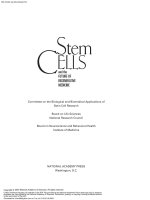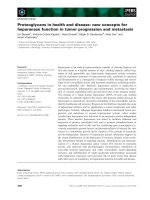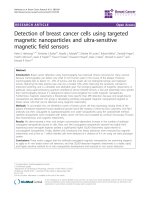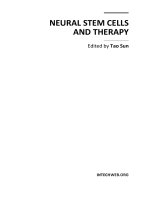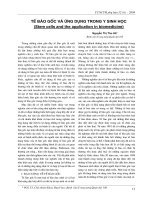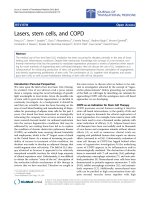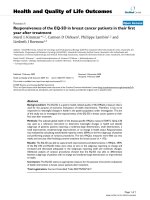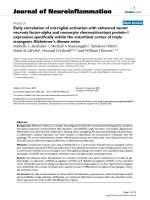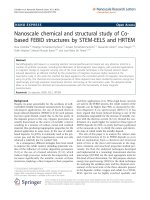BREAST CANCER – FOCUSING TUMOR MICROENVIRONMENT, STEM CELLS AND METASTASIS ppt
Bạn đang xem bản rút gọn của tài liệu. Xem và tải ngay bản đầy đủ của tài liệu tại đây (29.78 MB, 594 trang )
BREAST CANCER –
FOCUSING TUMOR
MICROENVIRONMENT,
STEM CELLS AND
METASTASIS
Edited by Mehmet Gunduz and Esra Gunduz
Breast Cancer – Focusing Tumor Microenvironment, Stem Cells and Metastasis
Edited by Mehmet Gunduz and Esra Gunduz
Published by InTech
Janeza Trdine 9, 51000 Rijeka, Croatia
Copyright © 2011 InTech
All chapters are Open Access distributed under the Creative Commons Attribution 3.0
license, which allows users to download, copy and build upon published articles even for
commercial purposes, as long as the author and publisher are properly credited, which
ensures maximum dissemination and a wider impact of our publications. After this work
has been published by InTech, authors have the right to republish it, in whole or part, in
any publication of which they are the author, and to make other personal use of the
work. Any republication, referencing or personal use of the work must explicitly identify
the original source.
As for readers, this license allows users to download, copy and build upon published
chapters even for commercial purposes, as long as the author and publisher are properly
credited, which ensures maximum dissemination and a wider impact of our publications.
Notice
Statements and opinions expressed in the chapters are these of the individual contributors
and not necessarily those of the editors or publisher. No responsibility is accepted for the
accuracy of information contained in the published chapters. The publisher assumes no
responsibility for any damage or injury to persons or property arising out of the use of any
materials, instructions, methods or ideas contained in the book.
Publishing Process Manager Silvia Vlase
Technical Editor Teodora Smiljanic
Cover Designer InTech Design Team
Image Copyright Piotr Marcinski, 2011. Used under license from Shutterstock.com
First published December, 2011
Printed in Croatia
A free online edition of this book is available at www.intechopen.com
Additional hard copies can be obtained from
Breast Cancer – Focusing Tumor Microenvironment, Stem Cells and Metastasis,
Edited by Mehmet Gunduz and Esra Gunduz
p. cm.
ISBN 978-953-307-766-6
free online editions of InTech
Books and Journals can be found at
www.intechopen.com
Contents
Preface IX
Part 1 Breast Cancer Cell Lines, Tumor Classification,
In Vitro Cancer Models 1
Chapter 1 Breast Cancer Cell Line Development and Authentication 3
Judith C. Keen
Chapter 2 In Vitro Breast Cancer Models as
Useful Tools in Therapeutics? 21
Emilie Bana and Denyse Bagrel
Chapter 3 Insulin-Like-Growth Factor-Binding-Protein 7:
An Antagonist to Breast Cancer 39
Tania Benatar, Yutaka Amemiya, Wenyi Yang and Arun Seth
Chapter 4 Breast Cancer: Classification Based on Molecular
Etiology Influencing Prognosis and Prediction 69
Siddik Sarkar and Mahitosh Mandal
Chapter 5 Remarks in Successful Cellular Investigations
for Fighting Breast Cancer Using Novel
Synthetic Compounds 85
Farshad H. Shirazi, Afshin Zarghi, Farzad Kobarfard,
Rezvan Zendehdel, Maryam Nakhjavani, Sara Arfaiee,
Tannaz Zebardast, Shohreh Mohebi, Nassim Anjidani,
Azadeh Ashtarinezhad and Shahram Shoeibi
Chapter 6 Breast Cancer from Molecular Point of View:
Pathogenesis and Biomarkers 103
Seyed Nasser Ostad and Maliheh Parsa
Part 2 Breast Cancer and Microenvironment 127
Chapter 7 Novel Insights Into the Role of Inflammation
in Promoting Breast Cancer Development 129
J. Valdivia-Silva, J. Franco-Barraza,
E. Cukierman and E.A. García-Zepeda
VI Contents
Chapter 8 Interleukin-6 in the Breast Tumor Microenvironment 165
Nicholas J. Sullivan
Chapter 9 The Role of Fibrin(ogen) in Transendothelial Cell
Migration During Breast Cancer Metastasis 183
Patricia J. Simpson-Haidaris, Brian J. Rybarczyk and Abha Sahni
Chapter 10 Hyaluronan Associated Inflammation and Microenvironment
Remodelling Influences Breast Cancer Progression 209
Caitlin Ward, Catalina Vasquez, Cornelia Tolg,
Patrick G. Telmer
and Eva Turley
Part 3 Breast Cancer Stem Cells 235
Chapter 11 The Microenvironment of Breast Cancer Stem Cells 237
Deepak Kanojia and Hexin Chen
Chapter 12 Involvement of Mesenchymal Stem Cells in
Breast Cancer Progression 247
Jürgen Dittmer, Ilka Oerlecke and Benjamin Leyh
Chapter 13 Breast Cancer Stem Cells 273
Fengyan Yu, Qiang Liu, Yujie Liu, Jieqiong Liu and Erwei Song
Part 4 Breast Cancer Gene Regulation 289
Chapter 14 Epigenetics and Breast Cancer 291
Majed Saleh Alokail
Chapter 15 Histone Modification and Breast Cancer 321
Xue-Gang Luo, Shu Guo, Yu Guo and Chun-Ling Zhang
Chapter 16 MCF-7 Breast Cancer Cell Line, a Model for the Study
of the Association Between Inflammation
and ABCG2-Mediated Multi Drug Resistance 343
Fatemeh Kalalinia, Fatemeh Mosaffa and Javad Behravan
Part 5 Breast Cancer Cell Interaction, Invasion and Metastasis 359
Chapter 17 Interaction of Alkylphospholipid Formulations with
Breast Cancer Cells in the Context of
Anticancer Drug Development 361
Tilen Koklic, Rok Podlipec, Janez Mravljak,
Marjeta Šentjurc and Reiner Zeisig
Chapter 18 The Mesenchymal-Like Phenotype of the
MDA-MB-231 Cell Line 385
Khoo Boon Yin
Contents VII
Chapter 19 p130Cas and p140Cap as the Bad and Good Guys
in Breast Cancer Cell Progression to an
Invasive Phenotype 403
P. Di Stefano, M. del P. Camacho Leal, B. Bisaro,
G. Tornillo, D. Repetto, A. Pincini, N. Sharma, S. Grasso,
E. Turco, S. Cabodi and P. Defilippi
Chapter 20 Fibrillar Human Serum Albumin Suppresses
Breast Cancer Cell Growth and Metastasis 423
Shao-Wen Hung, Chiao-Li Chu,
Yu-Ching Chang and Shu-Mei Liang
Chapter 21 On the Role of Cell Surface Chondroitin Sulfates and
Their Core Proteins in Breast Cancer Metastasis 435
Ann Marie Kieber-Emmons, Fariba Jousheghany
and Behjatolah Monzavi-Karbassi
Chapter 22 Endocrine Resistance and Epithelial Mesenchymal
Transition in Breast Cancer 451
Sanaa Al Saleh and Yunus A. Luqmani
Chapter 23 Junctional Adhesion Molecules (JAMs) -
New Players in Breast Cancer? 487
Gozie Offiah, Kieran Brennan and Ann M. Hopkins
Chapter 24 Breast Cancer Metastasis: Advances Through the
Use of In Vitro Co-Culture Model Systems 511
Anthony Magliocco and Cay Egan
Chapter 25 Breast Cancer Metastases to Bone:
Role of the Microenvironment 531
Jenna E. Fong and Svetlana V. Komarova
Chapter 26 Rho GTPases and Breast Cancer 559
Xuejing Zhang and Daotai Nie
Preface
Cancer is the leading cause of death in most countries and continues to increase
mainly because of the aging and growth of the world population as well as habitation
of cancer-causing behaviors such as smoking and alcohol. Based on statistics of the
GLOBOCAN 2008, about 12.7 million cancer cases and 7.6 million cancer deaths are
estimated to have occurred in 2008 (Siegel et al. Ca Cancer J Clin 61:212-236, 2011).
Breast cancer is the most frequently diagnosed cancer and the leading cause of cancer
death among females, accounting for 23% of the total cancer cases and 14% of the
cancer deaths. Thus cancer researches, especially breast cancer, are important to
overcome both economical and physiological burden. The current book on breast
cancer aims at providing information about recent clinical and basic researches in the
field. The book includes chapters written by well-known authors, who are worldwide
experts in their research areas. The current book covers topics such as characteristics of
breast cancer cells, molecular tumor classification methods, in vitro cancer models,
breast cancer and microenvironment, breast cancer stem cells, gene regulation in
breast cancer, and mechanism of breast cancer cell interaction, invasion as well as
metastasis. We hope that the book will serve as a good guide for the scientists,
researchers and educators in the field.
Prof. Dr. Mehmet Gunduz
Assoc. Prof. Dr. Esra Gunduz
Fatih University Medical School
Turkey
Part 1
Breast Cancer Cell Lines, Tumor Classification,
In Vitro Cancer Models
1
Breast Cancer Cell Line Development
and Authentication
Judith C. Keen
University of Medicine and Dentistry of New Jersey
USA
1. Introduction
Inarguably, the development of cell culture and the ability to grow human cells in vitro has
revolutionized medicine and scientific research. In the nearly sixty years since the first
successful culture of immortalized human tumor cells in the lab in 1952, new fields of
research have emerged and new scientific industries have been launched. Without cell lines,
medicine would not be as advanced as it is today. Modern techniques that allow for
manipulation of cell have allowed for a more complete understanding of the of fundamental
basics of cellular and molecular biology and the biological system as a whole.
Different types of cell lines exist. Lines are maintained as continuous cultures, are
established as primary cultures for transient studies, are created as explants of tumor or
tissue samples, or cultivated from a single individual cell. Cell lines, especially cancer cell
lines, are ubiquitous and are used for everything. By using cell lines, our understanding of
cells and genes, how they function or malfunction, and how they interact with other cells
has increased the pace of discovery and fundamentally changed how science is conducted.
Cell lines have been established as a model of specific disease types. Individual cell lines
have been derived from specific disease states and therefore possess specific characteristics
of that disease state. Therefore, they are exceptionally useful to gain insight into normal
physiology and how that physiology changes with onset of disease. Novel treatments and
therapeutic strategies are investigated in cell lines in order to gain a fundamental detailed
understanding of how a cell will react. Initial protocols are developed and tested in cell lines
prior to use in animal models or testing in humans. This has enormous implications in
discovery and reducing unintended side effects.
The first breast cancer cell line was established in 1958. Today, lines modeling the varied
types of breast cancer help to develop targeted therapy and to provide a molecular signature
of gene expression. Cell lines of estrogen/progesterone receptor (ER/PR) positive, ER/PR
negative, triple negative (ER/PR/Her2), normal mammary epithelium, metastatic disease,
and more are so widely used that it is nearly impossible to identify a recent discovery that
hasn’t used cell line models at some point during development.
Unfortunately, significant shortcomings of the use of cell lines exist. Cell lines are a model
system. They do not always predict the outcome in humans and therefore, do not replace
use of whole organisms. They are grown and tested in isolation, therefore the influence of
neighboring cells or organs is non-existent in cell culture systems. Over time, cells can
differentiate resulting in a change in phenotype from the original culture. Cell lines can
Breast Cancer – Focusing Tumor Microenvironment, Stem Cells and Metastasis
4
become contaminated by infectious agents such as mycoplasma or even by other cell lines.
Such contamination may not be readily detectable and can result in dramatically different
results leading to false or irreproducible data. Some of these issues can be addressed to
thwart the waste of reagents, money, and time. This includes testing and authenticating cell
lines while they are actively grown and in use in the lab. Companies exist that can test for
mycoplasma infection or DNA fingerprinting of cell lines to authenticate a particular cell
line. Other shortcomings are merely inherent to this model system and must simply be
identified and addressed.
2. A brief history of cell culture
Since the first successful establishment of a human cancer cell line in 1952, cell lines have
been the backbone of cancer research. They have provided the understanding of systems at
the molecular and cellular levels. Cell lines are used in the vast majority of research labs to
understand the fundamentals of basic mechanisms as well as the translation to clinical
settings.
Modern tissue culture techniques were made possible through the contributions of many
scientists across the world whose attempts to understand physiology and to establish a
source of tissue to study lead to fundamental changes in our understanding of biology and
medicine. Among the contributions include those of Sydney Ringer at the University
College London, who determined the ion concentrations necessary to maintain cellular life
and cell contractility, and ultimately created Ringers Solution. Through his seminal work in
the 1880s, Ringer described the concentrations of calcium, potassium and sodium required
to maintain contraction of a frog heart and began the steps towards modern day cell culture
(Miller, 2004; Ringer, 1882, 1883). In 1885, Wilhelm Roux at the Institute of Embryology in
Germany cultured chicken embryonic tissue in saline for several days. This was followed by
the work of Ross Harrison at the Johns Hopkins University in 1907, who was the first to
successfully grow nerve fibers in vitro from frog embryonic tissues. While this was the
outgrowth of embryonic tissue, these tissue cultures were successfully maintained ex vivo
for 1 - 3 weeks (Skloot, 2010)(Ryan, 2007b). In 1912, Alex Carrel at the Rockefeller Institute
for Medical Research successfully cultured the first mammalian tissue, chicken heart
fragments. He claimed to maintain beating chicken heart fragments in culture for over 34
years and outliving him by one year (Ryan, 2007a). Although controversy as to whether
these cultures were authentic or supplemented with fresh chicken hearts still remains
(Skloot, 2010). This controversy may have slowed progress towards the establishment of cell
lines in culture to some degree, it did not prevent work to create a source of material and
model systems to allow for testing in vitro.
It would be another 40 years before the establishment of the first continuously growing
human cell line, however steady advances towards that goal were ongoing. Carrel, working
with Charles Lindbergh, worked to create novel culturing techniques that included use of
pyrex glass. This glass could be heated and sterilized to reduce, or preferably eliminate,
bacterial contamination. This led to the creation of the D flasks in the 1930s which improved
cell culturing conditions by reducing contamination (Ryan, 2007c).
Tissue culture took another leap forward in 1948 when Katherine Sanford at Johns
Hopkins was the first to culture single mammalian cells on glass plates in solution to
produce the first continuous cell line (Earle et al., 1943; Sanford et al., 1948). Prior to this,
tissues were attached to coverslips, inverted and grown in droplets of blood or plasma.
Breast Cancer Cell Line Development and Authentication
5
Her work set the stage for modern practices of growing cells in media on plates or flasks
(Sanford et al., 1948).
2.1 Establishment of the HeLa cell line and cell line production
Indoubtedly, the most important factor to change biomedical research and our
understanding of disease at the cellular and molecular levels was the establishment of the
first continuously growing human cell line, the HeLa cell (Gey et al., 1952). In 1952,
Henrietta Lacks was a patient with adenocarcinoma of the cervix treated at the Johns
Hopkins Hospital. A portion of her tumor was used in the laboratory of George Gey at
Johns Hopkins University and the revolution of modern biomedical research began. These
cells were grown in roller flasks in specialized medium containing serum developed by
Evans and Earle et al. and continued to proliferate (Evans et al., 1951). Almost 60 years later,
these cells are still proliferating in laboratories across the globe and used to increase our
understanding of cellular mechanisms from cell signaling, to the implications of
weighlessness/zero gravity on cellular aging, and everything in between. The implications
of establishing this cell line have been tremendous and is still ongoing. HeLa cells have not
stopped growing and neither has the vast amount of knowledge gleened from them.
In 1953, Gey demonstrated that HeLa cells could be infected with the polio virus and
therefore were a useful tool for testing the efficacy of the polio vaccine that was under
development. This set the stage for the mass production of cell lines for distribution and use
worldwide. The National Science Foundation established the first production lab at the
Tuskegee Institute in 1953 that would provide HeLa cells to scientists involved in the
development of the polio vaccine (Brown and Henderson, 1983). The goal was to ship at
least 10,000 cultures per week. At the peak of production, 20,000 cultures were shipped per
week and a total of 600,000 cultures were shipped in the two years the lab was in existence
(Brown and Henderson, 1983). This, along with the Lewis Coriell’s development of the
laminar flow hood to reduce contamination of cell cultures and methods to freeze and
recover cell lines (Coriell et al., 1958; McGarrity and Coriell, 1973, 1974)(Coriell and
McGarrity, 1968; Greene et al., 1964; McAllister and Coriell, 1956; Silver et al., 1964), led to
the establishment of cell repositories to house and distribute cells. It also led to the
development of tumor specific cancer cell lines that created models of different types of
human cancer and to an explosion of understanding of how cells work without the influence
or perturbation of other cells. These models were also an ideal system to test novel
therapeutics and treatment strategies without use of whole animals or humans.
2.2 Culturing cells
The terms tissue culture and cell culture are used interchangeably, but in reality they are
two distinct entities. While both methods are derived from specific cells isolated from the
whole organism, the cultures established are quite different and used for different endpoints
(Freshney, 2010a).
Tissue, or primary, cultures are established from isolated tissue or organ fragment, most
commonly from tumor slices (McAteer and Davis, 2002). These primary cultures can be used
either for immediate experimentation to determine how primary cells operate or to establish
a continuous cell line. Generally, primary cultures are established through placing an organ
explant into culture media and allowing for outgrowth of cells or by digesting the tissue
fragment using enzymatic or mechanical digestion. By definition, these cultures are
Breast Cancer – Focusing Tumor Microenvironment, Stem Cells and Metastasis
6
transient. Primary culture refers to the period of time the primary tissue/organ fragment is
kept in culture in vitro prior to the first passage or subculturing of cells, at which time they
are referred to as a cell culture. This could range from days to a few weeks at most
(MacDonald, 2002).
Cell lines are primary cultures that have been subcultured or passaged and can be clonal,
terminal or immortalized cells (McAteer and Davis, 2002). Clonal cell cultures are created by
selecting a single cell that will proliferate to establish a single population. Terminal cell lines
are able to grow in culture for a few generations before senescence occurs and the cell line
can no longer survive in culture media. Immortalized cell lines are able to grow in culture
forever. These immortalized cell lines can occur naturally, such as HeLa cells, or through
transformation events, such as Epstein-Barr Virus transformation. All types of in vitro cell
cultures are used in breast cancer research.
3. The establishment of human breast cancer cell lines
The first human breast cancer cell line, BT-20, was established by Lasfargues and Ozzello in
1958 from an explant culture of a tumor slice from a 74 year old caucasian woman
(Lasfargues and Ozzello, 1958). These cells are estrogen receptor alpha (ER) negative,
progesterone receptor (PR) negative, Tumor Necrosis Factor alpha (TNF-α) positive, and
epidermal growth factor receptor (EGFR) positive (Borras et al., 1997). While BT-20 is the
oldest established breast cancer cell line, it is not the most commonly used line. By far, the
most widely used breast cancer cell line worldwide is the MCF-7 cell line (Table 1 and
Figure 1)(Burdall et al., 2003). Established in 1973 by Soule and colleagues at the Michigan
Cancer Foundation, from where it derives its name, MCF-7 cells were isolated from the
plural effusion of a 69 year old woman with metastatic disease (Soule et al., 1973). Since its
establishment, MCF7 has become the model of ER positive breast cancer (Lacroix and
Laclercq, 2004). Establishment of other cell lines has followed, including ones from other
breast cancer types such as BRCA mutant, triple negative, HER2 overexpressing, and those
derived from normal mammary epithelial cells such as MCF-10A cells (Soule et al., 1990)
(Table 2).
Cell line use in labs is ubiquitous and continues to increase. From 2000 - 2010, the
publication of manuscripts using the 10 most commonly used cell lines has almost tripled
(2.8% increase) (Figure 2). Clearly demonstrating that the importance of, need for, and use of
breast cancer cell lines will not diminish in the near future. Evaluation of the existing lines
indicates that most breast cancer cell lines in use are derived from metastatic cancer and not
other breast cancer phenotypes (Borras et al., 1997). Indeed, the overall success rate of
establishing a cell line is only 10%. Most of the cell lines that exist today have been derived
from pleural effusion instead of from primary tumors and are primarily ER - lines (Table 2
and reviewed in (Lacroix and Laclercq, 2004). This is surprising since ER - breast cancer is
detected in only 20 - 30% of all primary tumors, whereas ER + tumors are detected 55-60%
of the time (Ali and Coombes, 2000; McGuire et al., 1978). The reason for this discrepancy
remains unknown, however it has been postulated that this could be because ER - cells are
easier to establish in culture than ER + or that as cells are grown in culture, the epithelial like
phenotype is lost while more mesenchymal traits are retained, therefore cells in culture
appear to undergo a endothelial to mesenchymal transition (EMT) in vitro which is
associated with the ER - phenotype (Lacroix and Laclercq, 2004). This suggests that culture
systems are a model of metastatic disease that can grow in isolation and not a model the
Breast Cancer Cell Line Development and Authentication
7
wide heterogeneity of disease that is detected clinically. Although current cell lines are
derived form only a subset of primary cancers, overall these lines are a reliable model to
study the fundamental questions concerning cell growth, death, and the basic biology of
breast cancer. Indeed, many advances in breast cancer biology have been made using cell
culture systems and should not be dismissed because of these concerns.
Cell line
No of publications
1/1/2000 to 12/31/2010
origin
BT-20 79 breast
MCF7 11813 pleural effusion
MDA-MB-231 3489 pleural effusion
MDA-MB-435 * 719 pleural effusion
MDA-MB-468 486 pleural effusion
SkBr3 372 pleural effusion
T47D 1168 pleural effusion
ZR75.1 96 ascites
BT474 251 pleural effusion
MCF-10A 451 subcutaneous mastectomy
* not a breast cancer cell
line
Table 1. List of commonly used cell lines, the number of citations and their origin
3.1 Breast cancer cell lines as models of primary tumors
Using breast cancer cell lines clearly hold advantages over use of animal or human models.
Beyond the ethical implications of animal or human use, the advantages to using cell lines
include the ease of obtaining cell lines (can be purchased from commercial sources), the ease
of harvesting large numbers of cells (can be grown in culture for long periods of time to
accumulate the necessary concentration), and the ability to test an individual cell type
without confounding parameters such as other cell types or local microenvironment (to
date, no two cell lines can grown simultaneously in culture for extended periods).
Conversely, much debate has circulated concerning the applicability of the data derived
from isolated cell lines to the predicted outcomes in humans. One area that this debate has
been most contentious has been regarding the importance of the immune system in cancer
development. Clearly, the microenvironment and infiltrating immune cells contribute to
development and progression of disease, therefore individual cells grown in isolation will
lack the influence of other neighboring cells (Voskoglou-Nomikos et al., 2003). Genetic,
epigenetic and cytotoxicity studies that focus on outcomes in breast cells clearly benefit from
use of cell culture systems. The fundamental understanding of the underlying genetic or
molecular pathways involved in breast cell growth and its response to cytotoxic agents are
best understood in isolated cell culture systems (Voskoglou-Nomikos et al., 2003).
Breast Cancer – Focusing Tumor Microenvironment, Stem Cells and Metastasis
8
Fig. 1. The total number of publications per breast cancer cell line from 2000 through 2010.
The most commonly used cell line is the ER+ MCF7 cell line, followed by ER - MDA-MB-
231 cell lines. Many other cell lines are in use, however the number of publications using
these models is quite small. A. Total number of publications using breast cancer cell lines.
B. Each breast cancer cell line as a percentage of the total breast cancer cell lines used per
year.
Breast Cancer Cell Line Development and Authentication
9
Fig. 2. The total number of publications using breast cancer cell lines from 2000 through
2010. Use of breast cancer cell lines has steadily been rising since 2000.
Fig. 3. Number and percent of papers published using MDA-MB-435 cells from 2000 - 2010.
The tumor type that gave rise to MDA-MB-435 cells has been controversial since 2000. In
2004, STR profiling confirmed that MDA-MB-435 was not a breast cell line but rather has
been contaminated with the M4 melanoma cell line. There has been a subsequent drop in the
use and publication of these cells. Shown is the total number of papers published using
MDA-MB-435 cells (green bars) and the percent of the total number of publications use
MDA-MB-435 cells (blue circles). Arrow denotes when MDA-MB-435 were identified as
M14 melanoma cells.
Breast Cancer – Focusing Tumor Microenvironment, Stem Cells and Metastasis
10
cell line
year
established
origin
ER/PR
status
BT-20 1958 primary tissue -/?
SK-Br-3 1970 pleural effusion +/+
SW13 1971 ? ?
MDA-MB-134-VI 1973 pleural effusion +/-
MDA-MB-157 1973 pleural effusion ?
MDA-MB-175-VII 1973 pleural effusion ?
MDA-MB-231 1973 pleural effusion -/-
MDA-MB-361 1973 brain metastasis ?
MDA-MB-330 1973 pleural effusion ?
MDA-MB-415 1973 pleural effusion ?
MDA-MB-436 1973 pleural effusion ?
MDA-MB-453 1973 pleural effusion -/-
MDA-MB-468 1973 pleural effusion -/-
MDA-MB-157 1974 pleural effusion ?
MCF7 1974 primary tissue +/+
CAMA-1 1975 pleural effusion ?
SW527 1977 ? ?
Hs578Bst 1977 non-tumorigenic breast tissue -/-
Hs578T 1977 primary tissue -/-
ZR-75-1 1978 ascites +/+
ZR-75-30 1978 ascites ?
BT483 1978 primary tissue ?
DU4475 1979 primary tissue ?
T47D 1979 pleural effusion +/+
MCF10A 1984 non-tumorigenic breast tissue -/-
MCF10F 1984 non-tumorigenic breast tissue -/-
MCF10-2A 1984 non-tumorigenic breast tissue -/-
184A1 1985 normal mammoplasty (transformed) ?
184B5 1985 normal mammoplasty (transformed) ?
UACC-812 1986 primary tissue -/-
UACC-893 1987 primary tissue -/-
HCC38 1992 primary tissue -/-
HCC70 1992 primary tissue -/-
HCC202 1992 primary tissue -/-
HCC1008 1994 lymph node -/-
HCC1143 1994 primary tissue -/-
HCC1187 1994 primary tissue ?/-
Breast Cancer Cell Line Development and Authentication
11
cell line
year
established
origin
ER/PR
status
HCC1395 1994 primary tissue -/-
HCC1419 1994 primary tissue -/-
HCC1428 1995 pleural effusion ?
HCC1500 1995 primary tissue +/+
HCC1569 1995 primary tissue -/-
HCC1806 1995 primary tissue -/-
HCC1937 1995 primary tissue -/-
HCC1954 1995 primary tissue +/+
HCC2157 1995 primary tissue -/+
HCC2158 1996 primary tissue -/?
HCC1599 1998 primary tissue -/-
AU565 1998 pleural effusion ?
Table 2. Commercially available cell lines, their establishment date, and hormonal receptor
status
Debate has also centered on whether cell lines grown in culture maintain the same
genotypic/phenotypic changes that are detected in the primary tissues from which they
are derived. Characterization of breast cancer cell lines has been ongoing since their
establishment in 1958. In general, breast cancer cell lines are representative models of the
primary breast tumors they are derived from (Kao et al., 2009). Initial characterization
including karyotyping and comparative genomic hybridization (CGH) demonstrate that,
when created and propagated in culture, cell lines maintain the same mutations and
chromosomal abnormalities as their primary tumor samples (Lacroix and Laclercq, 2004).
While new mutations and chromosomal instability develop in cultured cell lines, overall
the genotype remains generally consistent between primary cells and cell lines (Lacroix
and Laclercq, 2004). Due to differences in the in vitro environment, lack of surrounding
naturally occurring microenvironment, and selection pressures, differentiation in culture
can occur (Kao et al., 2009; Lacroix and Laclercq, 2004; Voskoglou-Nomikos et al., 2003).
Because cancer cells are inherently unstable, differences between same cell line grown in
different labs under different environments, even if the growth conditions are the same,
are evident (Lacroix and Laclercq, 2004; Osborne et al., 1987). This impacts
experimentation as data derived from one lab may not be reproducible in another lab,
even is using the same cell line. Caution must be taken when relying on one or two cell
lines to draw conclusions.
Use of more modern molecular techniques to characterize cell lines has revealed that while
differences between primary cells and cell lines do exist. These techniques do confirm,
however, that cell lines maintain the molecular distinction found the primary tumors. Gene
expression changes detected in primary tumors are not dramatically different to those found
in culture systems, even when cultures are grown directly on plastic in 2D cultures or in
reconstituted 3D cultures (Vargo-Gogola and Rosen, 2007). Direct comparison of primary
tissue to cultured cells revealed “close similarities” between molecular profiles (Dairkee et
al., 2004). Indeed, even epigenetic changes found in primary cancers are similarly detected
Breast Cancer – Focusing Tumor Microenvironment, Stem Cells and Metastasis
12
in cell lines (Lacroix and Laclercq, 2004). This suggests that cell lines are an appropriate
model of primary disease and, depending on the research focus, cell lines will faithfully
reflect the processes of primary tissues.
Since cell lines generally remain faithful in terms of the molecular and genetic profiles of the
primary tumor from which they are derived, it is critical to consider the correct model
system. While ER/PR status of primary tumors leans predominantly toward ER+ expression
(55-60%), most breast cancer cell lines have been derived from ER - tumors or pleural
effusions (McGuire et al., 1978)(Table 2). Therefore it is of utmost importance to select the
proper model to answer the experimental question. A detailed analysis of the applicability
of cell lines to accurately model primary breast tumors revealed that overall breast cancer
cell lines as a whole do model primary tumors, however on an individual basis, one specific
cell line does not accurately mirror a primary breast tumor, even with the same gene
expression profile. Since variability in cell lines exist, it is generally thought that to more
accurately predict outcomes in primary tissue, a panel of breast cancer cell lines rather than
just 1 or 2 individual lines should be tested. Using panels more accurately reflects primary
breast tumors and will help translate findings from in vitro studies to in vivo therapeutic
options (Dairkee et al., 2004).
Microarray analysis clearly defined primary breast tumors and breast cancer cell lines at the
genetic level. Perou and others have conducted detailed studies using microarray platforms
and determined a molecular signature of gene expression changes found in primary breast
cancer tumors (Alizadeh et al., 2001; Perou et al., 1999b; Perou et al., 2000b; Ross et al., 2000;
Sorlie et al., 2001). These signatures are used to understand the molecular basis of breast
cancer and to define different subtypes of cancer that occur naturally in humans. It was also
developed as a diagnostic tool to detect breast cancer tumors earlier and to facilitate proper
treatment based on a gene signature. Based on these studies, 5 molecular signatures and
types of primary breast tumors have been identified. These are luminal A, luminal B, basal-
like, HER2+, and normal-like profiles (Perou et al., 1999a; Perou et al., 2000a; Ross et al.,
2000; Sorlie et al., 2001). Prior to establishment of these molecular signatures, diagnosis was
determined by receptor expression status, i.e. ER/PR/HER2, and treatment regimes
assigned accordingly. Using this molecular approach, luminal A and luminal B tend to also
be ER + expressing tumors, basal-like encompasses ER - tumors, HER2+ incorporate those
HER2+ expressing tumors, and normal-like have similar expression patterns to non-
cancerous cells (Perou et al., 1999a; Perou et al., 2000a; Ross et al., 2000; Sorlie et al., 2001).
Such molecular characterization will lead to providing more personalized therapy to
patients. Efficacy of drugs in different subtypes will be easily determined and accurately
assigned to patients expressing a similar molecular profile. While such personalized
medicine may be still in the future, some current breast cancer treatment options that exist
today are based on the molecular profile of the tumor. For example, tumors expressing the
estrogen receptor are treated with selective estrogen receptor modulator (SERM) or other
similar anti-estrogen compound whereas tumors lacking ER do not receive the same
therapy. Similarly, HER2+ tumors are susceptible to trastuzumab because of HER2
expression. In the future as molecular characterization improves and new
chemotherapeutics are developed, more personalized options will be available.
Do cell lines reflect the molecular signature of primary tumors? In a direct comparison of the
molecular profiles from cell lines and primary tumors, Kao et. al. found that instead of the 5
breast cancer subtypes identified in primary breast tumors, cell lines can be divided into
three main groups, luminal, basal A, or basal B phenotypes (Kao et al., 2009). Luminal cells
Breast Cancer Cell Line Development and Authentication
13
contained all ER + cell lines, both Basal A and B consisted of all ER - cell lines. HER2+ cell
lines were grouped into the luminal. Basal A contained the HCC cells and BRCA1 mutant
cells, whereas basal B genotype contained non-tumorigenic lines including MCF10A cells
(Kao et al., 2009). This highlights that breast cancer cell lines are a model of disease.
Cell lines are merely a model of breast disease that aim to provide clinical predictability of
outcomes in humans. To directly test the applicability of breast cancer cell lines, xenograft
cancer models, and mouse breast cancer models to clinical outcome, Voskoglou-Nomikos et.
al. compared outcomes in vitro to those in xenograft models, to mouse models and phase II
clinical trails (Voskoglou-Nomikos et al., 2003). In these comparisons, a general correlation
between relative risk (predictive value of a drug in cell line) and the phase II human trial
(tumor/control ratio) existed for in vitro cell lines. A general predictive value when using
xenograft models to predict outcome to chemotherapy was detected, however this was
dependent on the drug tested and the grade/type of tumor analyzed (Voskoglou-Nomikos
et al., 2003). Overall, Vaskoglou-Nomikos et. al. concluded that cell lines and xenograft
models were good predictors of clinical phase II trial outcomes, but are reliable predictors
only when testing cytotoxic drugs and when using the correct model system. These models
generally were not predictive of human outcomes when testing non-cytotoxic drugs
(Voskoglou-Nomikos et al., 2003). Taken together, these studies emphasize the critical need
to establish more breast cancer cell lines that model the heterogeneity of breast cancer and to
employ many in vitro and xenograft model systems using multiple cell lines per experiment
to reliably predict clinical outcome.
4. Contamination
Overt contamination of cell lines, such as bacterial, fungal or yeast infections, is readily
detectable merely by altered appearance of the culture and can be rectified without
impacting the quality or reproducibility of the data. Less overt contamination, such as
mycoplasma and cell line cross-contamination, can occur undetected and can seriously
jeopardize experimental findings. While it is well recognized that periodic testing for
mycoplasma is a necessary requirement when using cell lines, cross-contamination with
other cell lines is less recognized as a problem and therefore and cell authentication
practices are not routine.
Cell line cross-contamination is most evident in the case of MDA-MB-435 cells. When Ross
et. al. published the molecular profiles of breast cancer cell lines in 2000, the MDA-MB-435
cell line consistently fell outside the range of profiles of the other breast cancer cell lines and
clustered with melanoma cell lines (Ross et al., 2000). This sparked great debate about the
authenticity of the this line. Derived in 1976 from the pleural effusion of a 31 year old
patient with metastatic adenocarcinoma of the breast, initial debate suggested that this was
still a breast cancer cell line, but had been derived from a patient who may have also had
undiagnosed melanoma (Cailleau et al., 1978). Data indicating that MDA-MB-435 cells
expressed a mixture of both melanoma and epithelial markers fueled this debate, however
the overwhelming belief was the these were indeed breast cancer cells (Chambers, 2009;
Sellappan et al., 2004)(Figures 2 and 3). Indeed, early characterization of the cell line
indicated that they were highly metastatic and secrete milk proteins, findings consistent
with those of breast cancer cells (Howlett et al., 1994; Price, 1996; Price et al., 1990; Price and
Zhang, 1990; Sellappan et al., 2004; Suzuki et al., 2006; Welch, 1997). Confusingly, MDA-MB-
435 cells also expressed the melanocyte markers tyrosinase, melan A and S100 (Ellison et al.,
Breast Cancer – Focusing Tumor Microenvironment, Stem Cells and Metastasis
14
2002; Sellappan et al., 2004). Because of such conflicting results, these data just propagated
the debate instead of satisfactorily squelching it as intended. MDA-MB-435 cells were still
used and published as a breast cancer cell line (Figure 3).
Finally in 2007, DNA fingerprinting, or short tandem repeat (STR) analysis, in conjunction
with SNP analysis, cytogenetic analysis, and comparative genomic hybridization using the
earliest stocks of MDA-MB-435 cells revealed that these cells were identical to the M14
human melanoma cells and were melanoma rather than breast cancer cells (Garraway et al.,
2005)(Rae et al., 2007). Rae et. al., who conducted the analysis, concluded that at some point
early in passage, MDA-MB-435 cells were contaminated with M14 melanoma cells which
took over the colony, leading to the establishment of a M14 melanoma cell line rather than a
breast cancer line (Rae et al., 2007). This change was never detected. Stocks were
unknowingly mislabeled, marked as MDA-MB-435 cells and distributed. Still, after the
molecular characterization was published, debate as to whether MDA-MB-435 were really
M14 melanoma cells or if M14 were really MDA-MB-435 breast cell still existed (Chambers,
2009). Ultimately, it was determined that MDA-MB-435 cells were really M14, based on the
original 1974 publication that initially characterized the morphology, growth and
tumorigenicity of MDA-MB-435 cells. In the original paper, MDA-MB-435 cells were
reportedly non-tumorigenic in nude mice. After the initial creation in 1974, the MDA-MB-
435 cells were not extensively used for testing until the 1990s when Price et. al. used these
cells. At this time, MDA-MB-435 cells were characterized as a tumorigenic cell line (Cailleau
et al., 1978; Price, 1996; Price et al., 1990; Price and Zhang, 1990).
While impossible to reconstruct that actually happened, this indirect evidence suggests that
the MDA-MB-435 cells were contaminated with M14 melanoma cells and the original breast
cancer cells died off. Subsequent frozen stocks were of the contaminating M14 cell lines,
although they were labeled as MDA-MB-435 cells. No one was aware of this
misidentification. Therefore, M14 cells were masquerading as MDA-MB-435 cells and used
as a model of breast cancer until 2007. A total of 1803 PubMed indexed articles using MDA-
MB-435 cells were published over that period (Figure 3). Since 2007, however, the number of
publications using MDA-MB-435 cells has diminished, indicating that it is generally
accepted that these cells are clearly not breast cancer cells and therefore should not be used
as such.
4.1 Authentication
Cell line cross-contamination is hardly a new problem in tissue culture studies, although
it still remains largely ignored. When HeLa were the only human cell line and few
scientists studied them, cross-contamination was not a concern(Buehring et al., 2004;
Skloot, 2010). Now, it is estimated that 20 - 30% of all cell lines are inadvertently
contaminated (Alston-Roberts et al., 2010; Buehring et al., 2004; Gartler, 1968; Rojas and
Steinsapir, 1983). Gartler et. al, was the first to highlight the problem in 1967 at the Second
Decennial Review Conference on Cell, Tissue and Organ culture (Gartler, 1968). He was
the first to demonstrate that many cultures from many labs were contaminated with other
cell lines, primarily by HeLa cells. This meant that a significant amount of research was
incorrectly interpreted because it was conducted in a different cell line and therefore the
data were false. His findings were largely ignored. Over the years, others, including
MacLeod, Freshney, Nardone, Alston-R, Buehring and Capes-Davis, have also
documented contamination with HeLa and other cell lines, including cross-species
Breast Cancer Cell Line Development and Authentication
15
contamination, however this issue has rarely been adequately addressed (Alston-Roberts
et al., 2010; Bartallon et al., 2010; Buehring et al., 2004; Capes-Davis et al., 2010; Freshney,
2008; MacLeod et al., 2008; MacLeod et al., 1999; SDO et al., 2010). Recent efforts have
again been made to increase awareness of this problem and many calls for action have
been published (Buehring et al., 2004; Capes-Davis et al., 2010; Freshney, 2008, 2010b;
Lichter et al., 2010; MacLeod et al., 2008; MacLeod et al., 1999; SDO et al., 2010). A group
of concerned scientists gathered and created the ATCC Standard Development
Organization (ATCC SDO) to develop standards for cell authentication and with
maintaining databases of STR profiles.
Eliminating contamination has an easy solution. Cell line authentication using a
standardized technique, Short Tandem Repeat Analysis (STR), can provide an unique
DNA fingerprint of the cell line (Azari et al., 2007; Bartallon et al., 2010; Masters et al.,
2001; Nims et al., 2010; Parson et al., 2005). STR is inexpensive, standardized, and
provides proven methodology to produce cell line identities that is reproducible between
labs. An aliquot of DNA can be analyzed and compared with known STR profiles to
authenticate the cell line. STR profiles for the most commonly used cell lines are freely
available and STR services are available at many universities or companies. According to
the standards developed by the ATCC-SDO, cells in active use should be authenticated by
STR every 2 months (SDO et al., 2010). The ATCC-SDO also recommends that such
documentation of authenticity be provided with grant applications and with manuscript
submission. Many funding agencies and journals agree with this idea and suggest that
scientists provide such documentation prior to acceptance of a manuscript, however at
this time, this is merely a recommendation.
5. Future directions
Use of breast cancer cell lines as models of breast disease will not diminish in the near
future. These cell lines are an excellent resource to test novel hypotheses and to gain
greater understanding about how cells work and how breast cancer can be treated. On the
whole, the established cell lines are a good model for disease, however additional cell
lines should be created. The addition on new lines, especially those derived from various
forms of breast cancer will only strengthen the data gleaned from them. Likewise, cell
authentication should become a routine part of experimental procedures. By periodically
ensuring the cell lines being tested are truly the correct lines will eliminate the generation
and publication of false data. Authentication will save money and potentially careers if
done of a routine basis.
6. References
Ali, S., and Coombes, R.C. (2000). Estrogen receptor alpha in human breast cancer:
occurence and signficance. J Mammary Gland Biol Neoplasia 5, 271-281.
Alizadeh, A., Ross, D., Perou, C.M., and van de Rijn, M. (2001). Towards a novel
classification of human malignancies based on gene expression patterns. J Pathol
195, 41-52.
